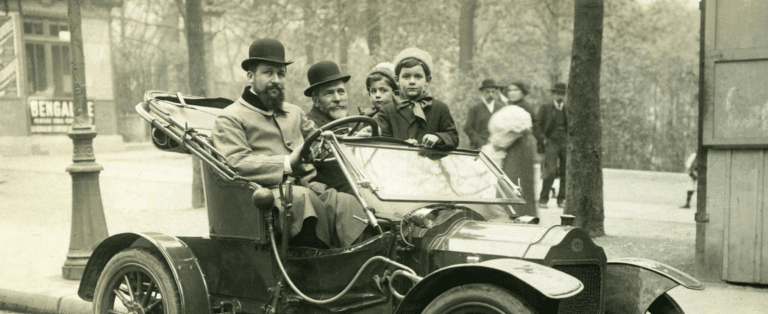Intending to figure out who remains in an old family photo, what year it was taken or what the reason for the shot was? There is no doubt that finding the who, when, where and why of family images is one of the most gratifying kinds of genealogical sleuthing there is, however sometimes the job can appear almost impossible. The bright side is, there are some techniques that can assist. If you’ve been fortunate enough to get your hands on some old images, following the steps listed below can help you finally decipher them.
We suggest that you also take this time to digitize your old photos. Doing so preserves them and can also reveal hidden information. You can find tips for doing so here.
4 Simple Steps to Help You Decipher Old Family Photos

Action 1: Determine Photo Ownership
Whose image, picture album or collection was it? Who took or owned the image? Ask member of the family to help you sort it out, or use ideas from the photos to narrow it down.
Understanding this information will help you identify which branch of the household it originated from and will make a big distinction if you’re attempting to make sense of notes on the back. Considering that people typically write things such as “Aunt Maggie at her wedding” rather of “Maggie Margaret Jones at her wedding event in West Falls in 1921,” knowing who took or owned a photo initially can offer you a huge running start finding out exactly who is in it, as well as the date and place it was taken.
Step 2: Group Like Objects
Like items attract other like objects. Although it’s an excellent concept to concentrate on one photo at a time, it can be a lot more helpful to use a group of images to solve your secret. Take some time to arrange your collection before diving into all of your questions.
People typically take multiple images, not one single shot, and you are most likely to recognize photos of the exact same individual, household group, time period or location. Select the kind of sorting that makes the most sense for your collection and get this out of the way. You might be surprised what you find out simply by finishing this activity.
Action 3: Look for Clues to the Who, When, Where and Why
— Take Notes
Now is the time to begin taking notes about each picture. This will assist you keep track of everything you learn and want to find out.
You might likewise want to get a magnifying glass or download an app for zoom on your phone so that you can check out the great details.
— Start Asking Questions
Now that you have a place to bear in mind, get a photo or group of photos and explain what you see. Start with any writing. Is there any on the front? On the back? Is the composing hand-lettered, stamped, embossed, typed? Is it pencil or ink? Write it all down.
Utilize what you learn about the image’s owner to make sense of what is written. Who or what remains in the photo? What are they doing? What is the focus of the event? Are the people seated or standing? Are they close in age or far apart? Are they dressed in daily clothes or something fancy? Is the scene natural or posed? Every image has a story to inform.
Do the pictures include details that assist to pinpoint its locale? Are the household members in the mountains or at the beach?
Start dating the picture by trying to find clues about the people you know. How young do they search in this image? Compare this image to other photos of them– putting the shots in sequential order to catch the exact time this picture was taken.
What kind of image it is likewise matters greatly when dating. Is it black and white or color? Was color used with dyes? Is the photo on a big postcard? Is it a tintype? The type of picture can assist connect it to a specific time in history. Tintypes were produced from 1860 to 1875. Big postcard images were popular after 1900. Polaroids were developed in the 1970s. Find a guide to photo types here to help.
— Understand the Details
Determine the style, architecture, art, and transportation within the picture. These can tell you so much by helping you place the photo in a specific place and time. Break down the style you see by asking questions. When did guys wear white shoes or bowler hats? When did females use puffed sleeves?
Tweak the time of year by questioning the clothing and natural forms that you see. Are trees in complete bloom or are people surrounded by mounds of white snow? Are females wearing flowing skirts and short-sleeved tops? Are the men wearing white shoes? White was typically not worn up until Easter Sunday or even Memorial Day.
Try to find wedding event rings to identify who is married and not, this can assist you position the photo in a timeline.
Search utilizing historical, style and architectural keywords. Did you understand that you can also utilize Google Chrome image searches to link your images to others found within the around the world web? Do not take my word for it, learn more here.
Step 4: Place it in Your Family Tree
Some of the above-mentioned questions may seem overly specific, these information can assist you place the image at a specific occasion in your tree– such as a wedding or baptism– and you need to be doing this for every old image you have. Repeat this process with each individual in the picture, examining them along with the date( s) and events of their lives.The picture above included only one person in it that I understand; my grandma.
My paternal grandma owned this image. Years after she died, my cousin shared it with me, in the hopes that I could recognize the people. My grandmother, I believe, is the female on the right side, who seems a bridesmaid.
Within the pictures I got, there was another photo that I could organize it with; a solo shot of my grandmother in the extremely exact same gown. That photo was hand-colored, making her dress pink. Hand-coloring was a popular technique to include color to black-and-white pictures in the early 1900s.
My grandmother was clearly part of a wedding party. The space consists of a backdrop in which the wedding event celebration is formally posing. The carpet appears real, nevertheless the stunning trompe l’oeil windows are painted on a backdrop. If you look carefully on the bottom right side of the image, you can discover the canvas hanging in front of a wooden structure.
Understanding that my granny invested most of her life in Baltimore, Maryland, I would presume that the wedding event took place there. The picture is printed on heavy matte image paper, and is 8″ X 10″ in size. The only writing on this photo is a series of backwards printed numbers written in white, on the front of the picture, “15216” and “36.”.
To date this image through fashion, I would browse within Pinterest for men’s white shoes, girls’ puffed sleeves, ladies’s wavy short hairstyles, and large striped ties. The men’s shoes pop right off the page, they are so unique and were absolutely from the early 1930s. The brief sleeves and white shoes together mean a possible Spring or Summer wedding event.
The only fashion jewelry I spot includes my grandmother’s cross necklace and the ring on the other bridesmaid’s hand (left wing). The reality that my grandmother has no wedding event band tells me that she is single. My grandmother married in 1931, so the date of this photo can be separated to before that time.
I find it interesting that she is on the best side with 2 guys. My grandma had three siblings. Maybe she is flanked by two of them in this image. When I examine this photo, attempting to date it using my existing family tree, I find that it is probably not her eldest brother’s wedding. He married in 1925, when my grandmother was just eleven. She looks a bit older in this picture.
Her youngest brother married in 1936, after my granny wed. The lack of a wedding event band eliminates that circumstance. Her middle bro and his better half most likely married around 1930, having their very first child in February of 1931. It seems quite plausible that they wed in the Spring of 1930 or potentially even the Summer of 1929.
When I investigate my ancestral tree in depth, I find that her middle brother and his better half were cohabiting as man and wife in the 1930 census, with the bride’s moms and dads. The census specifies that she was 21 and he was 25 when they wed. He was born in 1904 and she in 1909. From this, I can presume that they married in 1930. My grandma was age 16, single and living with her moms and dads in the 1930 census.
At this point, I feel really confident about three people in the picture, my granny and the bride and groom. I would continue to examine them utilizing family tree details for her family or stop here, having actually pleased my own household connections.
Use these suggestions to understand your own family images and you never understand what you might discover. If the battle is higher than you believed, do not be afraid to enlist the assistance of others.
Host a Photo Detective Party or post photos online to family groups or Facebook. Welcome your cousins, aunts and uncles to chime in or even bring their picture albums over for an afternoon of solving photo mysteries. Maybe they have copies of the very same pictures, but theirs have labels that solve your secret instantly.

Leave a Reply